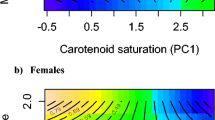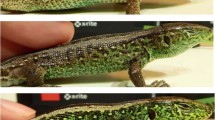Abstract
Ornamental traits are thought to evolve because they give individuals an advantage in securing multiple mates. Thus, the presence of ornamentation among males in many monogamous bird species presents something of a conundrum. Under certain conditions, extra-pair paternity can increase the variance in reproductive success among males, thus increasing the potential for sexual selection to act. We addressed this possibility in the mountain bluebird (Sialia currucoides), a socially monogamous songbird in which males possess brilliant ultraviolet (UV)-blue plumage. Specifically, we asked whether a male’s success at siring offspring within his own nest and within the nests of other males was related to his coloration. In pairwise comparisons, males that sired extra-pair offspring were not more colorful than the males that they cuckolded. However, males that sired at least one extra-pair offspring were, on average, brighter and more UV-blue than males that did not sire extra-pair offspring. Brighter, more UV-blue males sired more offspring both with their own mate and tended to sire more offspring with extra-pair mates and thus sired more offspring overall. Our results support the hypothesis that the brilliant UV-blue ornamental plumage of male mountain bluebirds evolved at least in part because it provides males with an advantage in fertilizing the eggs of multiple females.




Similar content being viewed by others
References
Andersson M (1994) Sexual selection. Princeton University Press, Princeton
Arnold SJ, Wade MJ (1984) On the measurement of natural and sexual selection: theory. Evolution 38:709–719
Balenger SL, Johnson LS, Brubaker JL, Ostlind E (2007) Parental effort in relation to structural plumage coloration in the mountain bluebird (Sialia currucoides). Ethology 113:838–846
Balenger SL, Johnson LS, Mays HL, Masters, BS (2008) Extra-pair paternity in the socially monogamous mountain bluebird (Sialia currucoides) and its effect on the potential for sexual selection. J Avian Biol (in press)
Bent AC (1949) Life histories of North American thrushes, kinglets, and their allies. US Nat Mus Bull 195
Bitton P-P, O’Brien EL, Dawson RD (2007) Plumage brightness and age predict extrapair fertilization success of male tree swallows, Tachcineta bicolor. Anim Behav 74:1777–1784
Cotton S, Small J, Pomiankowski A (2006) Sexual selection and condition-dependent mate preferences. Curr Biol 16:R755–R756
Criddle N (1927) Habits of the mountain bluebird in Manitoba. Can Field-Nat 41:40–44
Cuthill IC, Bennett ATD, Partridge JC, Maier EJ (1999) Plumage reflectance and the objective assessment of avian sexual dichromatism. Am Nat 153:183–200
Darwin C (1871) The descent of man, and selection in relation to sex. Murray, London
Dearborn DC, Anders AD, Parker PG (2001) Sexual dimorphism, extrapair fertilizations, and operational sex ratio in great frigatebirds (Fregata minor). Behav Ecol 12:746–752
Delhey K, Peters A, Johnsen A, Kempenaers B (2007) Fertilization success and UV ornamentation in blue tits Cyanistes caerulus: correlational and experimental evidence. Behav Ecol 18:399–409
Dunn PO, Robertson RJ, Michaud-Freeman D, Boag PT (1994) Extra-pair paternity in tree swallows – why do females mate with more than one male? Behav Ecol Sociobiol 35:273–281
Estep LK, Mays H, Keyser AJ, Ballentine BE, Hill GE (2005) Effects of breeding density and coloration on mate guarding and cuckoldry in blue grosbeaks (Passerina caerulea). Can J Zool 83:1143–1148
Faircloth BC, Keller GP, Nairn CJ, Palmer WE, Carroll JP, Gowaty PA (2006) Tetranucleotide microsatellite loci from eastern bluebirds Sialia sialis. Mol Ecol Notes 6:646–649
Fisher RA (1958) The genetical theory of evolution. Dover, New York
Freeman-Gallant CR, Wheelwright NT, Meiklejohn KE, States SL, Sollecito SV (2005) Little effect of extrapair paternity on the opportunity for sexual selection in savannah sparrows (Passerculus sandwichensis). Evolution 59:422–430
Gowaty PA (1985) Multiple parentage and apparent monogamy in birds. In: Gowaty PA, Mock DW (eds) Avian monogamy. American Ornithologists Union, Washington, pp 11–21
Griffith SC, Pryke SR (2006) Benefits to females of assessing color displays. In: Hill GE, McGraw KJ (eds) Bird Coloration, Vol 2. Harvard University Press, Cambridge, pp 233–279
Griffith SC, Owens IPF, Thuman KA (2002) Extra pair paternity in birds: a review of interspecific variation and adaptive function. Mol Ecol 11:2195–2212
Heywood JS (1989) Sexual selection by the handicap mechanism. Evolution 43:1387–1397
Hill GE (2006) Female mate choice for ornamental coloration. In: Hill GE, McGraw KJ (eds) Bird coloration, vol 2. Harvard University Press, Cambridge, pp 137–200
Hill GE, Doucet SM, Buchholz R (2005) The effect of coccidial infection on iridescent plumage coloration in wild turkeys. Anim Behav 69:387–394
Hoelzer GA (1989) The good parent process of sexual selection. Anim Behav 38:1067–1078
Johnson LS, Brubaker JL, Ostlind E, Balenger SL (2006) Effect of altitude on male parental expenditure in Mountain Bluebirds (Sialia currucoides): are higher altitude males more attentive fathers? J Ornith 148:9–16
Johnstone RA (1995) Sexual selection, honest advertisement and the handicap principle: reviewing the evidence. Biol Rev 70:1–65
Jones AG, Walker D, Kvarnemo C, Lindstrom K, Avise JC (2001) How cuckoldry can decrease the opportunity for sexual selection: data and theory from a genetic parentage analysis of the sand goby, Pomatoschistus minutus. Proc Natl Acad Sci U S A 98:9151–9156
Jones AG, Arguello JR, Arnold SJ (2002) Validation of Bateman’s principles: a genetic study of sexual selection and mating patterns in the rough-skinned newt. Proc R Soc Lond B 269:2533–2539
Kirkpatrick M, Price T, Arnold SJ (1990) The Darwin–Fisher theory of sexual selection in monogamous birds. Evolution 44:180–193
Kodric-Brown A, Brown JH (1984) Truth in advertising: the kinds of traits favored by sexual selection. Am Nat 124:309–323
Kraaijeveld K, Carew PJ, Billing T, Mulder RA (2004) Extra-pair paternity does not result in differential sexual selection in the mutually ornamented black swan (Cygnus atratus). Mol Ecol 13:1625–1633
Kvarnemo C (2006) Evolution and maintenance of male care: is increased paternity a neglected benefit of care? Behav Ecol 17:144–148
Kvarnemo C, Ahnesjö I (1996) The dynamics of operational sex ratios and competition for mates. Trends Ecol Evol 11:404–408
Lane RK, Pearman M (2003) Comparison of spring return dates of Mountain Bluebirds, Sialia currucoides, and Tree Swallows, Tachycineta bicolor with monthly air temperatures. Can Field-Nat 117:110–112
Liebgold EB, Cabe PR, Jaeger RG, Leberg PL (2006) Multiple paternity in a salamander with socially monogamous behaviour. Mol Ecol 15:4153–4160
McGraw KJ, MacKillop EA, Dale J, Mauber ME (2002) Different colors reveal different information: how nutritional stress affects the expression of melanin- and structurally-based ornamental coloration. J Exp Biol 205:3747–3755
Mills SC, Grapputo A, Koskela E, Mappes T (2007) Quantitative measure of sexual selection with respect to the operational sex ratio: a comparison of selection indices. Proc R Soc Lond B 274:143–150
Møller AP, Tegelstrom H (1997) Extrapair paternity and tail ornamentation in the barn swallow Hirundo rustica. Behav Ecol Sociobiol 41:353–360
Monk D (1999) Differential allocation of parental care in free-ranging mountain bluebirds. Indiana University, Bloomington
Montgomerie R (2008) CLR version 1.0. Queen’s University, Kingston, Canada. http://post.queensu.ca/∼mont/color/analyze.html
Montgomerie R (2006) Analyzing colors. In: Hill GE, McGraw KJ (eds) Bird coloration, vol. 1. Harvard University Press, Cambridge, pp 90–147
O’Donald P (1972) Natural selection of reproductive rates and breeding times and effect on sexual selection. Am Nat 106:368–379
Perrier G, de Lope F, Møller AP, Ninni P (2002) Structural coloration and sexual selection in the barn swallow Hirundo rustica. Behav Ecol 13:728–736
Peters A, Dlhey K, Johnsen A, Kempenaers B (2007) The condition-dependent devlopment of carotenoid-based and structural plumage in nestling blue tits: males and females differ. Am Nat 169:S122–S136
Power HW (1966) Biology of mountain bluebird in Montana. Condor 68:351–371
Power HW, Lombardo MP (1996) Mountain bluebird (Sialia currucoides). In: Poole A, Gill F (eds) The birds of North America, No 222. The American Ornithologists Union, Washington
Prum R (2006) Anatomy, physics, and evolution of structural colors. In: Hill GE, McGraw KJ (eds) Bird Coloration, Vol 1. Harvard University Press, Cambridge, pp 295–353
Quesada J, Senar JC (2006) Comparing plumage colour measurements obtained directly from live birds and from collected feathers: the case of the great tit Parus major. J Avian Biol 37:609–616
SAS Institute (2007) SAS/STAT user’s guide. Version 9.1. SAS Institute Inc, Cary, NC, USA
Senar JC (2006) Color displays as intrasexual signals of aggression and dominance. In: Hill GE, McGraw KJ (eds) Bird coloration, vol. 2. Harvard University Press, Cambridge, pp 87–136
Seutin G, White BN, Boag PT (1991) Preservation of avian blood and tissue samples for DNA analysis. Can J Zool 69:82–90
Shawkey MD, Balenger SL, Hill GE, Johnson AK, Keyser AJ, Siefferman L (2006) Mechanisms of evolutionary change in structural plumage coloration among bluebirds (Sialia spp.). J R Soc Interface 3:527–532
Sheldon BC, Ellegren H (1999) Sexual selection resulting from extrapair paternity in collared flycatchers. Anim Behav 57:285–298
Siefferman L, Hill GE (2003) Structural and melanin coloration indicate parental effort and reproductive success in male eastern bluebirds. Behav Ecol 14:855–861
Siefferman L, Hill GE (2005a) Male eastern bluebirds trade future ornamentation for current reproductive investment. Biol Lett 1:208–211
Siefferman L, Hill GE (2005b) Evidence for sexual selection on structural plumage coloration in female eastern bluebirds (Sialia sialis). Evolution 59:1819–1828
Siefferman L, Hill GE (2005c) UV-blue structural coloration and competition for nestboxes in male eastern bluebirds. Anim Behav 69:67–72
Siefferman L, Hill GE (2007) The effect of rearing environment on blue structural coloration of eastern bluebirds (Sialia sialis). Behav Ecol Sociobiol 61:1839–1846
Siefferman L, Hill GE, Dobson FS (2005) Ornamental plumage coloration and condition are dependent on age in eastern bluebirds Sialia sialis. J Avian Biol 36:428–435
Stutchbury BJM, Piper WH, Neudorf DL, Tarof SA, Rhymer JM, Fuller G, Fleischer RC (1997) Correlates of extra-pair fertilization success in hooded warblers. Behav Ecol Sociobiol 40:119–126
Thusius KJ, Peterson KA, Dunn PO, Whittingham LA (2001) Male mask size is correlated with mating success in the common yellowthroat. Anim Behav 62:435–446
Webster MS, Pruett-Jones S, Westneat DF (1995) Measuring the effects of pairing success, extra pair copulations and mate quality on the opportunity for sexual selection. Evolution 49:1147–1157
Westneat DF (2006) No evidence of current sexual selection on sexually dimorphic traits in a bird with high variance in mating success. Am Nat 167:171–189
Westneat DF, Sherman PW, Morton ML (1990) The ecology and evolution of extra-pair copulations. Curr Ornithol 7:331–369
Whittingham LA, Dunn PO (2005) Effects of extra-pair and within-pair reproductive success on the opportunity for selection in birds. Behav Ecol 16:138–144
Yezerinac SM, Weatherhead PJ (1997) Extra-pair mating, male plumage coloration and sexual selection in yellow warblers (Dendroica petechia). Proc R Soc Lond B 264:527–532
Zahavi A (1975) Mate selection—selection for a handicap. J Theor Biol 53:205–214
Acknowledgments
B. Beuf, R. Berry, and the Garber family granted permission to work on their property. D. Newman, the Powderhorn Bluebird Club, and R. Berry allowed us access to their nest boxes at the low-elevation site. H. Golden of the US Forest Service allowed us access to nest boxes at our high elevation site and provided logistical support. B. Beuf provided living accommodations at the low-altitude site and much moral support. R. Young and the staff of Bear Lodge Resort provided accommodations at the high-altitude site. J. Eastman built many of the nest boxes used in this study. B. Johnson, J. Brubaker, and E. Ostlind assisted in the field. Special thanks to L. Siefferman for invaluable help in collecting and analyzing spectral data, as well as for sharing her expertise with regards to bluebird coloration. E. Scully, Q. Lupton, M. Liu, W. Hood, G. Hill, and two reviewers provided comments, which improved the manuscript considerably. Financial support came through grants from Sigma Xi (SLB), Towson University’s Faculty Development and Research Committee and Undergraduate Research Committee and from the National Science Foundation (grants DBI-9732442 and IBN-0316541). To all, we are grateful. All methods contained within this manuscript comply with current laws of the USA.
Author information
Authors and Affiliations
Corresponding author
Additional information
Communicated by S. Pruett-Jones
Rights and permissions
About this article
Cite this article
Balenger, S.L., Johnson, L.S. & Masters, B.S. Sexual selection in a socially monogamous bird: male color predicts paternity success in the mountain bluebird, Sialia currucoides . Behav Ecol Sociobiol 63, 403–411 (2009). https://doi.org/10.1007/s00265-008-0674-5
Received:
Revised:
Accepted:
Published:
Issue Date:
DOI: https://doi.org/10.1007/s00265-008-0674-5




